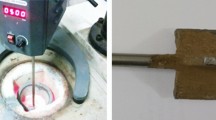Abstract
Damping capacities of cast aluminium alloy-mica particle composites were measured using a torsional pendulum method at a constant strain amplitude. The damping capacity of aluminium alloys progressively increases with increasing amounts of mica particles dispersed in the matrix, within the range investigated. The percentage increase in damping capacity at any level of mica is several times greater than the volume per cent of mica particles present in the matrix. The ratios of the specific damping capacity to density of aluminium alloy-mica particle composites (above 2% of mica) are greater than that of cast iron. Machinability tests on aluminium alloy-mica composites carried out at different speeds indicated that the average length and weight of individual chips decreases with increasing amounts of mica particles in the matrix. The percentage increase in the number of chips per gram of composite was several times the volume per cent of mica particles present in the composite. A decrease in the size of chips due to mica dispersions is a major asset since it permits faster machining speeds. Measurements of coefficient of thermal expansion showed very marginal increases in the aluminium alloys as a result of 2% mica dispersions. The electrical resistivity measurements of aluminium-mica composites using Kelvin's double bridge showed increases in electrical resistance of the order of 14% as a result of 2.2% mica additions. The measured increases in the electrical resistivity and coefficients of expansion are higher than the values calculated from the presently established theories of composite materials.
Similar content being viewed by others
References
F. A. Badia and P. K. Rohatgi, AFS Trans. 2 (1969) 902.
Idem, SAE Trans. 76 (1969) 1200.
V. G. Gorbundy, V. D. Parshin and V. V. Panin, Russ. Cast. Prod. August (1974) 348.
B. C. Pai, P. K. Rohatgi and S. Venkatesh, Wear 30 (1974) 117.
B. C. Pai and P. K. Rohatgi, Trans. Indian Inst. Met. 27 (1974) 97.
P. K. Rohatgi and B. C. Pai, Int. J. Lubric. Tech. 101 (1979) 376.
A. M. Patton, J. Inst. Met. (C) (1972) 197.
M. K. Surappa and P. K. Rohatgi, Met. Tech. 5 (1978) 358.
M. Suwa, K. Momuro and K. Soono, Nippon Kinzoku, Grakkaishi 41 (1977) 511.
B. C. Pai and P. K. Rohatgi, J. Mater. Sci. 13 (1978) 329.
S. Ray, B. C. Pai, K. V. Prabhakar and P. K. Rohatgi, Mater. Sci. Eng. 24 (1976) 31.
B. P. Krishnan, P. K. Rohatgi and H. R. Shetty, Trans. Amer. Foundrymens Soc. 76–86 (1976) 73.
B. P. Krishnan, S. Raman and P. K. Rohatgi, Proceedings of the International Wear Conference, Michigan, USA, 1979, p. 160.
P. K. Rohatgi, B. C. Pai and P. C. Panda, J. Mater. Sci. 14 (1979) 2277.
Deonath, R. T. Bhat and P. K. Rohatgi, J. Mater. Sci. 15 (1980) 1241.
Deonath, S. K. Biswas and P. K. Rohatgi, Wear 60 (1980) 61.
P. K. Rohatgi, N. Murali, H. R. Shetty and R. Chandrasekhar, Mater. Sci. Eng. 26 (1976) 115.
J. G. Kaufman, Mater. Des. Eng. (1962) 104.
M. A. O. Fox and R. D. Adams, J. Mech. Eng. Sci. 15 (1973) 81.
R. D. Adams and M. A. O. Fox, J. Iron Steel Inst. 211 (1977) 37.
E. P. Bowden and D. Tabor, “Friction and Lubrication Solids”, (Clarendon Press, Oxford, 1974) p. 199.
V. K. Agrawal, Hindustan Aluminium Corporation, Renukoot, UP, India, private communication, July 1980.
P. S. Turner, J. Res. Natl. Bur. Std. 37 (1946) 239.
J. P. Thomas, “Effect of Inorganic Fillers on the Coefficient of Thermal Expansion of Polymeric Materials”, General Dynamics/Fort Worth, Texas, AD 287-826. (As noted from J. Composite Mater. 1 (1967) 119.)
Charless L. Mantell, “Engineering Materials Handbook”, (McGraw-Hill Book Co., New York, 1958) p. 35.
J. C. Maxwell, A Treatise on Electricity and Magnetism”, Vol. 1, 3rd edn, (Clarendon Press, Oxford, 1892) p. 440.
L. H. Van Vlack, “Materials Science for Engineers”, (Addison-Wesley Publishing Company, London, 1973) p. 407.
L. K. H. Van Beek, “Progress in Dielectrics”, Vol. 7 (Heywood, London, 1967) p. 69.
Author information
Authors and Affiliations
Rights and permissions
About this article
Cite this article
Deonath, Narayan, R. & Rohatgi, P.K. Damping capacity, resistivity, thermal expansion and machinability of aluminium alloy-mica composites. J Mater Sci 16, 3025–3032 (1981). https://doi.org/10.1007/BF00540308
Received:
Accepted:
Issue Date:
DOI: https://doi.org/10.1007/BF00540308



